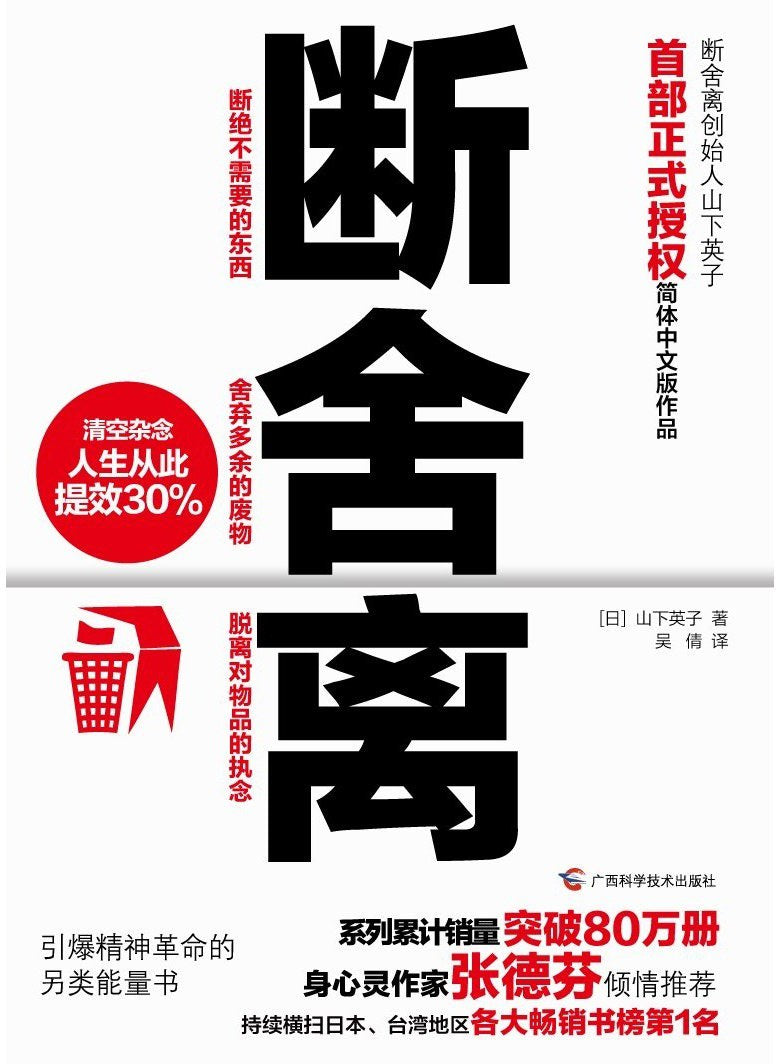WULOLIFE
《断舍离》作者: 山下英子 原作名: 新・片づけ術「断捨離」
《断舍离》作者: 山下英子 原作名: 新・片づけ術「断捨離」
Sale
Sold out
Regular price
€15,00 EUR
Regular price
Sale price
€15,00 EUR
Unit price
per
Tax included.
Shipping calculated at checkout.
Couldn't load pickup availability
Description
内容简介 · · · · · ·
“断舍离”是由日本杂物管理咨询师山下英子提出的人生整理观念。所谓断舍离,就是透过整理物品了解自己,整理心中的混沌,让人生舒适的行动技术。换句话说,就是利用收拾家里的杂物来整理內心的废物,让人生转而开心的方法。其中,断=断绝不需要的东西,舍=舍弃多余的废物,离=脱离对物品的执着。
断舍离非常简单,只需要以自己而不是物品为主角,去思考什么东西最适合现在的自己。只要是不符合这两个标准的东西,就立即淘汰或是送人。
通过学习和实践断舍离,人们将重新审视自己与物品的关系,从关注物品转换为关注自我——我需不需要,一旦开始思考,并致力于将身边所有“不需要、不适合、不舒服”的东西替换为“需要、适合、舒服”的东西,就能让环境变得清爽。
作者简介 · · · · · ·
山下英子
生于东京,大学期间开始学习瑜伽,并通过瑜随后便致力于提倡以这种概念为基础的、任何人都能亲身实践的新整理术“断舍离”,通过对日常家居环境的收拾整理,改变意识,脱离物欲和执念,过上自由舒适的生活。
从2000年起,以杂物管理咨询师的身份在日本各地举行断舍离讲座,引起日本 NHK、TBS、东京电视台、《每日新闻》 离讲座成为社会流行话题,掀起了一轮又一轮全Note:
目录 · · · · · ·
什么是断舍离第一章断舍离的机制断舍离是不收拾的收拾法从关系轴和时间轴看物品为了维持好心情而收拾与整理术、收纳术有什么不一样筛减物品带来的自我察觉夺回被占据的空间和能量从衣柜开始,来一场自我改革吧!
从不穿的衣服着手,也改变了人际关系由实践到意识的转变过程和物品成为好朋友磨砺内在的感应力东西要用才有价值断舍离专栏1 蒙古人与断舍离的生活法第二章我们为什么没办法收拾——无法丢弃的理由物质陷阱入口是“断”的闸门,出口是“舍”的闸门香鱼变成鲶鱼了吗三种“扔不掉东西”的人“总之我就是不想待在家里!”——逃避现实型“那些回不去的幸福时光”——执着过去型“没有了就会很不安”——担忧未来型对“现在”的界定因人而异扔不掉就是不想扔当杂物占据了空间没有收拾的屋子就像“便秘”
代表停滞和腐朽运的灰尘与杂物破烂儿还可以分三类认清自己与物品之间的关系时间轴要锁定在“现在”
不要把重点放在“非日常”上找回对自己的信任由减分法变成加分法由忽视和否定而来的能量让房间变乱的心理重新思考住所的意义断舍离以“住育”为目标提升对居住环境的意识让家成为最棒的放松地断舍离专栏2 南丁格尔口中的居住环境与健康第三章 先从整理头脑开始——断舍离的思考法则以自我为轴心,把时间轴放在“当下”
“自我轴心”的窍门——注意提问时的主语将物品比作人际关系,了解“当下”的含义厘清“扫除”的整“断舍离的漩涡”
的两种含义活着就是不断选择的过程给还是觉得“扔不掉”、“没法送人”的你断舍离专栏3 小松老铺房屋推广计划——死而复苏的老屋第四章身体开始行动——断舍离的实践方法提高收拾动机的方法只集中于一点,把它搞完美,以此提高动机根据目的选择不同的场所一切都从扔东西开始从“怎么看都是垃圾”的东西开始下手垃圾分类这道墙垃圾的三大类扔的时候要说“对不起”和“谢谢”
把东西送给别人时,要说“请收下”
将大、中、小“三分法”用到整理收纳上厨房里的“三分法”
为什么分成三类刚刚好利用七,五、一的总量限制原则,裕的空间从空间里限制物品数量伴随总量限制原则的“替换原则”
打造物品外观形态的两大原则只需一个动作原则自立、自由、自在法则“每次主义”就挺好断舍离专栏4断舍离的级别第五章 前所未有的畅快和解放感——看不见的世界在变化自动法则:启动自动整理的机制自动整理的机制断舍离与自动化利用物品不断提升自己存留下的物品是自观的途径试着使用高于自我形象的物品断舍离并非要提倡清简的生活更多“看不见的变化”会发生从自力到外力的加速变关于“碍事”这个词接受来自未知世界的支援从“拥有”这种观念中解放出来后记
从不穿的衣服着手,也改变了人际关系由实践到意识的转变过程和物品成为好朋友磨砺内在的感应力东西要用才有价值断舍离专栏1 蒙古人与断舍离的生活法第二章我们为什么没办法收拾——无法丢弃的理由物质陷阱入口是“断”的闸门,出口是“舍”的闸门香鱼变成鲶鱼了吗三种“扔不掉东西”的人“总之我就是不想待在家里!”——逃避现实型“那些回不去的幸福时光”——执着过去型“没有了就会很不安”——担忧未来型对“现在”的界定因人而异扔不掉就是不想扔当杂物占据了空间没有收拾的屋子就像“便秘”
代表停滞和腐朽运的灰尘与杂物破烂儿还可以分三类认清自己与物品之间的关系时间轴要锁定在“现在”
不要把重点放在“非日常”上找回对自己的信任由减分法变成加分法由忽视和否定而来的能量让房间变乱的心理重新思考住所的意义断舍离以“住育”为目标提升对居住环境的意识让家成为最棒的放松地断舍离专栏2 南丁格尔口中的居住环境与健康第三章 先从整理头脑开始——断舍离的思考法则以自我为轴心,把时间轴放在“当下”
“自我轴心”的窍门——注意提问时的主语将物品比作人际关系,了解“当下”的含义厘清“扫除”的整“断舍离的漩涡”
的两种含义活着就是不断选择的过程给还是觉得“扔不掉”、“没法送人”的你断舍离专栏3 小松老铺房屋推广计划——死而复苏的老屋第四章身体开始行动——断舍离的实践方法提高收拾动机的方法只集中于一点,把它搞完美,以此提高动机根据目的选择不同的场所一切都从扔东西开始从“怎么看都是垃圾”的东西开始下手垃圾分类这道墙垃圾的三大类扔的时候要说“对不起”和“谢谢”
把东西送给别人时,要说“请收下”
将大、中、小“三分法”用到整理收纳上厨房里的“三分法”
为什么分成三类刚刚好利用七,五、一的总量限制原则,裕的空间从空间里限制物品数量伴随总量限制原则的“替换原则”
打造物品外观形态的两大原则只需一个动作原则自立、自由、自在法则“每次主义”就挺好断舍离专栏4断舍离的级别第五章 前所未有的畅快和解放感——看不见的世界在变化自动法则:启动自动整理的机制自动整理的机制断舍离与自动化利用物品不断提升自己存留下的物品是自观的途径试着使用高于自我形象的物品断舍离并非要提倡清简的生活更多“看不见的变化”会发生从自力到外力的加速变关于“碍事”这个词接受来自未知世界的支援从“拥有”这种观念中解放出来后记
